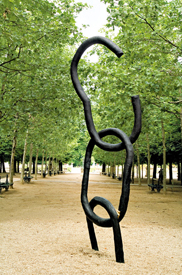
October 18 - October 22, 2007 |
FIAC 2007 - ARCHETYPE
|
Grand Palais, Paris
|

exhibition release
FIAC 2007
Grand Palais, Paris – October 18-22
VALERIE BELIN
FRANCESCO CLEMENTE
GEORGE CONDO
KEITH HARING
FABRICE HYBER
JEFF KOONS
McDERMOTT & McGOUGH
DAVID MACH
SHIRIN NESHAT
A.R. PENCK
PIERRE ET GILLES
BETTINA RHEIMS
BENJAMIN SABATIER
YI ZHOU
For several years now the gallery has had a stand at the FIAC, the international fair for contemporary art, choosing a theme to give cohesion to the works it displays by artists whose artistic expressions are very different. Wishing to actively contribute to FIAC’s renewed prestige after its return to the Louvre Carrousel and Grand Palais, following Signes et Prodiges in 2006, the gallery decided this year to display exceptional new, original works along with other older works on the basic theme of the Archetype.
ARCHETYPE (from the Greek arkhetupos, primitive model): 1. Model on which a work is constructed 2. Philos.: a. For Plato an idea, a form of the intelligible world from which objects of the sensible world are constructed. b. For empirists an idea that serves as a model for another.
Contemporary creation refuses any idea of archetype in its « academic » interpretation, refusing the idea of a model to be followed to achieve perfection but, paradoxically, reviving this idea in multiple forms around the concept of prototype, since today each artist determines his or her own archetype, which is the vector of his or her creative approach.
In the past artists only had to respect the archetype, like a collective model to which they had to comply, just as they had to respect established symbols, whether in religious or mythological scenes or portraits or landscapes. Today the archetype is more an image, a textual element, a concept or a strong intellectual representation stemming from our collective iconography but on which an artist imposes his or her individual interpretation to give it the desired meaning.
Fabrice Hyber constructs his work in the image of his thoughts that function like a gigantic rhizome, passing from one theme or medium to another. He integrates into his paintings words, signs and drawings that enable the viewer to follow the proposed aesthetic and intellectual reasoning. When, to evoke the abolition of slavery, he creates the sculpture Le cri, l’écrit (2007), whose monumental version in the Jardins du Luxembourg in Paris was inaugurated by Presidents Chirac and Sarkozy on 10 May this year, his approach corresponds exactly to this process. He created this sculpture with 2 very different faces, whilst retaining the universal symbol of the broken chain.
A.R. Penck and Keith Haring have sought to define a universal iconographic language, like a new visual esperanto … The figure of Standart, defined by Penck as a universal human figure that can be identified and reproduced by all, without any specific cultural reference, is, in fact, what inspired the American artist when he gave birth to Radiant Child, this primitive silhouette that can evoke a human child or adult and which he very expressively places in situation to convey his messages on AIDS, power, money, the media, etc. In addition each of these two artists use their own specific, very rich symbolism to give birth to their own archetypes: for Penck the eagle, the German Imperial emblem, symbolizes supreme power whereas Haring uses a much more contemporary image of flying saucers.
As for the work of Jeff Koons, it is entirely directed at creating new archetypes, through references to our consumer society’s media images, sexuality and childhood. In his first works, such as Pot (1979) from the The Pre-New series, the artist was in fact seeking to “free himself from his own subjective sexuality” to bring “his work into the objective area” …
« Pierre et Gilles represent a union of sexes through archetypes » as Koons explains so well, to enable us to reach a level of non-judgement. The couple refuse to be tied to traditional archetypes, to respect established frontiers between popular and elitist culture, between good and bad taste, between homosexuality and heterosexuality, between soberness and luxuriance … In their portraits, everything is mixed and, paradoxically, gives birth to a unique style, identifiable among all others despite the diversity of the themes treated.
The young artist Benjamin Sabatier uses socio-economic archetypes, in particular logos, to make us question current links between art and mass production / consumption.
And to close this multiple vision of contemporary archetypes Yi Zhou unveils her Limbo flags (2006), hand-drawn and painted flags that take us directly back to “Limbo” in The Divine Comedy by Dante where all those without an ideal or ideology inevitably end up following each other and are therefore forced to run behind these standards.
PRESS CONTACT: Emmanuelle de Noirmont / Ludyvine Travers-Pitrou
Phone: +33 (0)1.42.89.89.00 / Fax: +33 (0)1.42.89.89.03 / E-mail: info@denoirmont.com
IMAGES 300 dpi available on request at the gallery.









